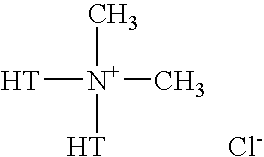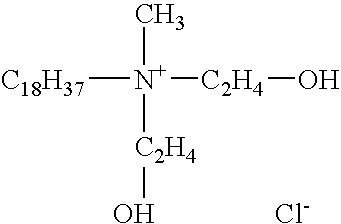Clay/organic chemical compositions useful as additives to polymer, plastic and resin matrices to produce nanocomposites and nonocomposites containing such compositions
a technology of organic chemical compositions and compositions, which is applied in the field of improved clay/organic chemical compositions, can solve the problems of difficult dispersibility in the matrix, voids or chambers between the separate layers, and the production of organoclays of lower quality
- Summary
- Abstract
- Description
- Claims
- Application Information
AI Technical Summary
Benefits of technology
Problems solved by technology
Method used
Image
Examples
example 2
Some of the compositions from Example 1 were selected at random and further tested to determine their ability to disperse in a thermoplastic polymer. PETG, a glycol modified polyester from Eastman Chemical, was used. The polyester was melted and worked on a roll mill at 350.degree. F. for 2 minutes to form a melt and an amount of the compositions indicated on Table II was added to the polyester. The dispersion results obtained are indicated in Table II.
Description of Results
It is clear that a wide variety of hybrid organoclay compositions prepared according to this invention gave varying satisfactory degrees of dispersion by both visual inspection and SEM / X-Ray probe measurements.
example 3
Several materials were prepared to compare with the hybrid organoclays the dispersibility in PETG resin of 1) traditional organoclays without intercalated polymer, and 2) clays containing intercalated polymer and no quaternary salt. The former materials were prepared as described in U.S. Pat. No. 4,105,578, and the latter by the procedure set forth below:
In a baffled three liter reactor with efficient stirring was placed 1350 g of a prehydrated aqueous hectorite or bentonite clay slurry (concentration of clay ca. 3.0%). The slurry was heated to 70-80.degree. C. with stirring and organic materials as shown below, at a level of 30% based on calculated clay weight, were added to the slurry. The mixture was then mixed at temperature for an additional 45 minutes and poured into a large stainless steel pan. The materials were oven dried at 65.degree. C., followed by mastication, grinding, and sifting to provide a final product less than 325 mesh.
The materials were incorporated into PETG r...
example 4
The hybrid organoclay designated sample 21B (Example 1) was tested against a standard organoclay product, BENTONE 38, for efficiency as a rheological additive in coatings. The two materials were incorporated into a standard aromatic gloss alkyd enamel at 1.00% and their Brookfield and Stormer viscosities measured. The results are shown in Table IV.
Description of Results
While not as efficient as a standard organoclay in this particular example, Sample 21B provided enhanced viscosity to the enamel well within the effective range for rheological additives.
PUM
| Property | Measurement | Unit |
|---|---|---|
| thickness | aaaaa | aaaaa |
| thickness | aaaaa | aaaaa |
| thickness | aaaaa | aaaaa |
Abstract
Description
Claims
Application Information
 Login to View More
Login to View More - R&D
- Intellectual Property
- Life Sciences
- Materials
- Tech Scout
- Unparalleled Data Quality
- Higher Quality Content
- 60% Fewer Hallucinations
Browse by: Latest US Patents, China's latest patents, Technical Efficacy Thesaurus, Application Domain, Technology Topic, Popular Technical Reports.
© 2025 PatSnap. All rights reserved.Legal|Privacy policy|Modern Slavery Act Transparency Statement|Sitemap|About US| Contact US: help@patsnap.com



